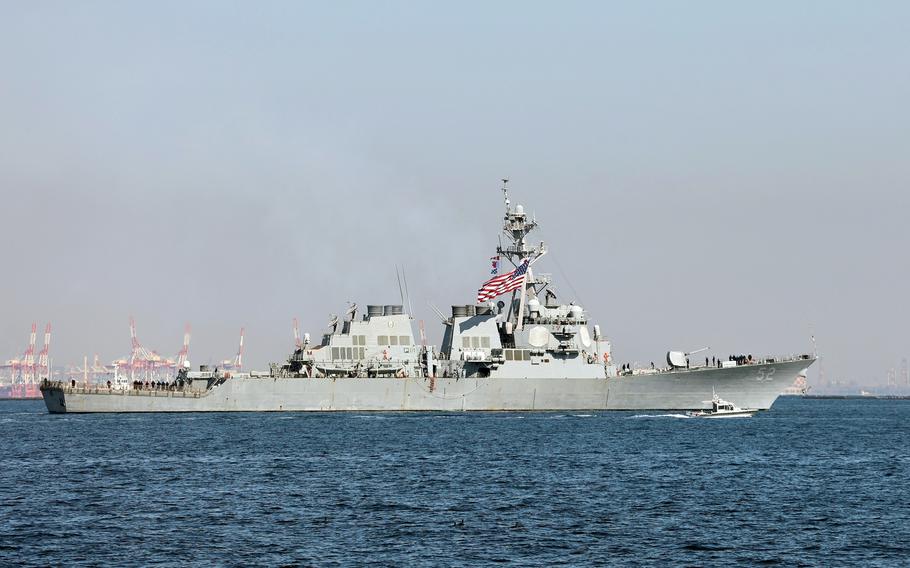
The guided-missile destroyer USS Barry departs Yokosuka Naval Base, Japan, while shifting its homeport to Naval Station Everett, Wash., Friday, Feb. 17, 2023. (Emilio Mackie/U.S. Navy)
YOKOSUKA NAVAL BASE, Japan – The guided-missile destroyer USS Barry steamed out of Tokyo Bay on Friday, beginning a 17-day journey to the United States and concluding nearly seven years in the Indo-Pacific region.
The Barry will steam toward its new homeport, Naval Station Everett, Wash., where it’s scheduled for routine maintenance, the U.S. 7th Fleet said in a Friday news release.
“Barry and her crew stood the watch in the Western Pacific for nearly seven years,” said Capt. Walt Mainor, commander of Destroyer Squadron 15 and Carrier Task Force 71. “She leaves with an incredible legacy of being the Navy’s oldest destroyer who still accomplished the mission. She held the line and provided incredible firepower to our team without fail.”
The Arleigh Burke-class destroyer arrived in Japan in March 2016 and routinely joined the Ronald Reagan Carrier Strike group on its patrols. The Barry participated in seven multinational exercises, visited 12 foreign ports and sailed nearly 3.8 million miles during its time in the Indo-Pacific, according to the news release.
The destroyer also made regular passage through the Taiwan Strait and participated in freedom-of-navigation operations near contested island chains in the South China Sea.

The guided-missile destroyer USS Barry departs Yokosuka Naval Base, Japan, while shifting its homeport to Naval Station Everett, Wash., Friday, Feb. 17, 2023. (Joseph Keiley/U.S. Navy)
In April 2020, the Barry steamed near the Paracel Islands, a group of about 100 islands between Vietnam and the Philippines. The Barry’s trip was the first of two back-to-back freedom-of-navigation operations, with the second made by the guided-missile cruiser USS Bunker Hill near the Spratly Islands.
The two island chains are claimed in full by China, Taiwan and Vietnam. Beijing routinely objects to other nations’ warships passing near them. Li Huamin, a spokesman for China’s Southern Theater Command, at the time called the Barry’s actions “provocative” and said it “deliberately increased regional security risks.”
Six months later, the Barry steamed through the Taiwan Strait, another activity that routinely draws criticism from Beijing. China considers Taiwan a breakaway province that must be reunited with the mainland. The Barry made the trip again in November 2020, the 12th that year by a Navy vessel.
The destroyer passed through the strait again in September 2021. Army Senior Col. Shi Yi, a spokesman for China’s Eastern Theater Command, at the time said the transit demonstrated that the U.S. is a “destroyer of peace and stability” and a “security risk creator” in the region.
The Navy, however, describes its activities in the region as crucial to maintaining “a free and open Indo-Pacific
“USS Barry participated in numerous events that contributed to the security and stability of the vital Indo-Pacific region and sets a high standard for destroyer Sailors left to carry on the mission in Japan,” 7th Fleet spokeswoman Lt. Kristina Wiedemann told Stars and Stripes in an email Friday.
The Barry is replaced by the USS Shoup, which joined 7th Fleet in December. It is the fifth Flight IIA destroyer in Destroyer Squadron 15 capable of accommodating two MH-60 Seahawk helicopters.
“The security environment in the Indo-Pacific requires that the U.S. Navy station the most capable ships forward,” Wiedemann said. “This posture enables rapid response times for maritime and joint forces and brings our most capable ships with the greatest amount of striking power and operational capability to bear.”